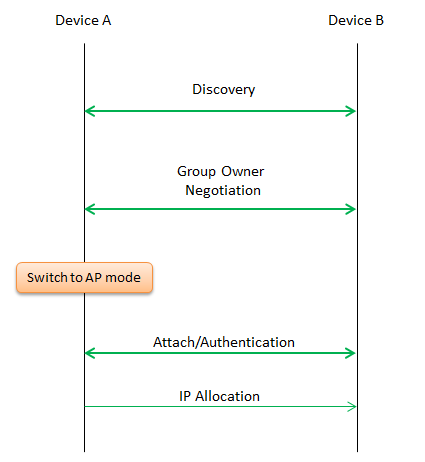|
WiFi Direct
WiFi Direct is a kind of mechanism by which two (or more) WiFi device can talk to each other directly without going through WiFi Access Point. If you are more familiar with how Bluetooth works, you may take 'WiFi Direct' as 'WiFi working like a Bluetooth, but it is much faster since it is communicating over WiFi'.
As of now (May 2015), I saw most of lated mobile phones support this function and you may find a lot of digital TVs and other electronic commodities with labels on it 'WiFi Direct'.
In this page, I will talk about how WiFi Direct works (In 3GPP Rel 12, D2D is proposed for LTE and we may see similar concept in LTE when D2D will be finalized. They would call the LTE version of direct communication as LTE Direct). Overall protocol sequence to establish WiFi Direct connection can be illustrated as below.

- Discovery : This step is basically same as the discovery process in normal WiFi operation (Refer to WLAN Protocol page for the details). The main difference between WiFi Direct and Normal WiFi operation in this step is that both device is transmitting Beacon with SSID = DIRECT in WiFi Direct device. Or they can perform discovery via Probe Request/Probe Response.
- Group Owner Negotiation : Even though 'WiFi Direct' may sound like 'the two device would communicate with equal right', in reality one of the device will be working as Access Point (a kind of Master) and the other device will act as a slave. Group Owner Negotiation is a process to determine who will become the Master and who will become the slave. This step is done three step handshake - GO Negotiation Request, GO Negotiation Response, Go Negotiation Confirmation.
- Switch to AP mode on Group Owner : Once a Group Owner(GO) is determined, the grouple owner switches its chipset to AP mode (Access Point mode) and start working as a Access Point.
- Attach Authentication : Now the other device (the device not selected as Group Owner) performs attach process with the GO device. Basically this is similar to normal WiFi operation(Refer to WLAN Protocol page for the details).
- IP Allocation : At last, GO device allocate IP to Non-GO devices to complete IP layer end-to-end communication path.
|
|
